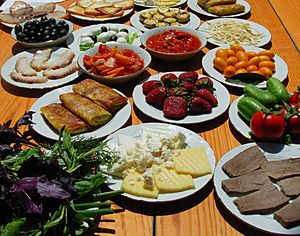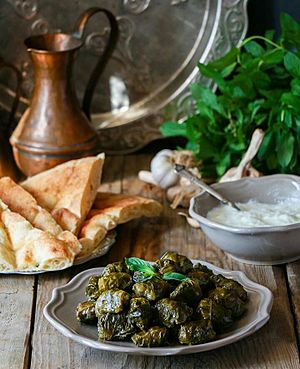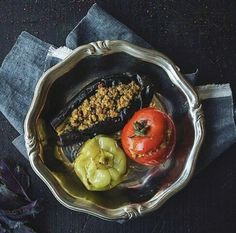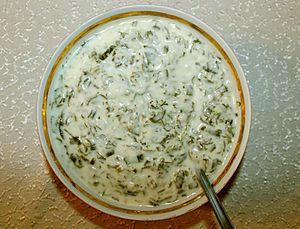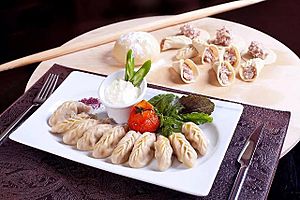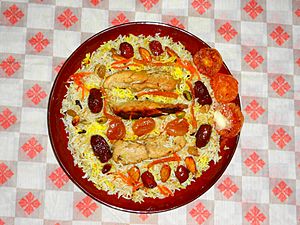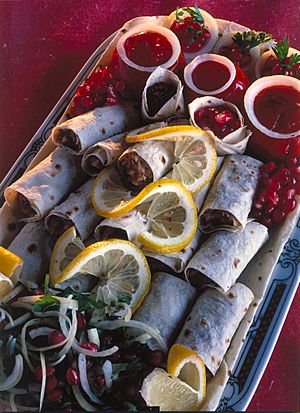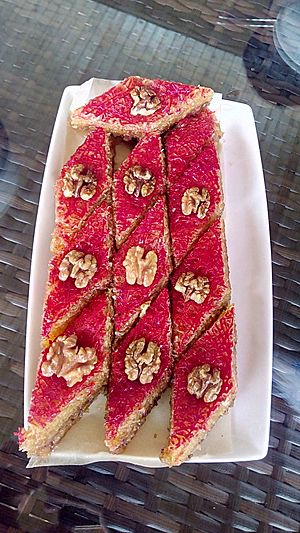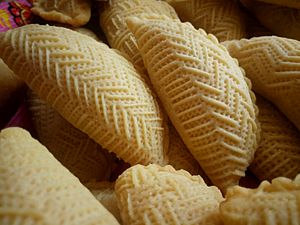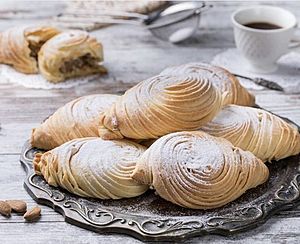Azerbaijani food facts for kids
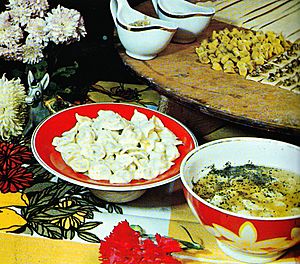
Azerbaijani cuisine (Azerbaijani: Azərbaycan mətbəxi) is the special way of cooking and the tasty dishes from the country of Azerbaijan. This food style is shaped by Azerbaijan's rich farming land, which has many green areas perfect for raising animals. It's also influenced by Azerbaijan's unique spot where Europe and Asia meet, right next to the Caspian Sea. This location helps people enjoy a wide variety of foods like fresh produce, milk products, and different meats such as beef, lamb, fish, and even game. Because many kingdoms and empires have ruled this area, Azerbaijani food has also been shaped by cooking traditions from places like Turkic, Iranian, and Eastern European cultures.
Contents
- What Makes Azerbaijani Food Special?
- What Do Azerbaijanis Eat for Breakfast?
- Tasty Light Snacks and Side Dishes
- Main Dishes: Meat and Fish
- Warm and Hearty Soups
- Plov: A National Treasure
- Spices: The Secret to Flavor
- Sweet Treats and Desserts
- Dairy Products: A Daily Essential
- Breads: A Staple Food
- See also
What Makes Azerbaijani Food Special?
Azerbaijan's national food is quite similar to Middle Eastern cuisine. This is because of the flavors and how dishes are made, often using dark spices and special flavorings. Today, Azerbaijani cooking still uses old ways of preparing food, but it also includes modern cooking styles.
Traditionally, Azerbaijani dishes are cooked using copper pots and pans. Even now, copper bowls and plates are often used to serve meals.
Azerbaijani food uses many fruits and vegetables. These include aubergine (eggplant), tomato, sweet pepper, spinach, cabbage, onion, sorrel, beet, radish, cucumber, and green beans. Rice and foods made from flour are also very common. Fresh herbs like mint, coriander, dill, basil, parsley, tarragon, leek, chive, thyme, marjoram, green onion, and watercress often come with main dishes. Most national dishes use lamb, beef, and chicken. Dishes made with minced (ground) meat are also popular. The seas, lakes, and rivers in Azerbaijan have many types of fish, especially the white sturgeon. Sturgeons are often used in national dishes. The Caspian Sea, in particular, is home to many fish you can eat, such as sturgeon, Caspian salmon, kutum, sardines, and grey mullet. Black caviar from the Caspian Sea is one of Azerbaijan's most famous luxury foods.
A typical Azerbaijani meal usually has three parts. One of the main dishes is plov, which is rice colored with saffron and served with different herbs and greens. This is different from plovs found in Uzbekistan. Other main dishes include various kebabs and shashlik, made with lamb, beef, chicken, duck, and fish (baliq) kebabs. Sturgeon fish is often grilled on a skewer as a shashlik and served with a tangy pomegranate sauce called narsharab. Dried fruits and walnuts are used in many dishes. Common condiments are salt, black pepper, sumac, and especially saffron, which grows locally on the Absheron Peninsula. The third part of the meal often includes soups, and there are more than 30 kinds! These include kufta bozbash, piti (made with meat), and dovga, ovdukh, dogramach, and bolva (made with greens and yogurt).
Black tea is the national drink. It's usually enjoyed after a meal. It's also offered to guests as a warm welcome, often with fruit preserves.
What Do Azerbaijanis Eat for Breakfast?
Azerbaijani breakfasts are full of dairy products like butter, different kinds of white cheese, and cream. They also include honey, tandoori bread, and eggs. Eggs are traditionally made into kuku, but sometimes they are scrambled. Breakfast traditions from Eastern Europe, which came from the Russian Empire and the Soviet Union, are also sometimes seen in Azerbaijani homes. These can include foods like kasha (porridge), quark (a type of fresh cheese), and crepes.
Tasty Light Snacks and Side Dishes
Azerbaijani food has many light snacks and side dishes that start or go with the main meals. These include a plate of green leaves called goy, pieces of chorek (bread), choban (a salad with tomato and cucumber), white cheese or qatik (sour yogurt), and turshu (pickles). This way of eating is similar to Turkish meze. The bigger main dishes like soups, meats, and plov are served after these snacks.
Main Dishes: Meat and Fish
Historically, Azerbaijani food included a lot of beef and game meat. Eating camel meat was also common, but it's much rarer now. To keep meat fresh long ago, it was dried or roasted and put into jars or animal stomachs. Besides regular cuts of meat, Azerbaijani cooking also uses parts like the head, legs, tails, and intestines of animals in many traditional dishes.
Azerbaijani cuisine has a wide range of traditional meat dishes. Some examples are bozbash (like parchabozbash, kuftebozbash, qovurmabozbash), piti (gence piti, sheki piti), khash, bash-ayaq (kelle-pacha), kelepir, soyutma, bozport, buglama, bozartma, and many different kebabs. Various lamb dishes are also commonly eaten, especially during celebrations like Nowruz. Meatball dishes and types of dolma are also eaten regularly. For very special events, local goose, turkey, duck, quail, and pheasant meats are cooked and enjoyed.
Azerbaijani food also features many seafood dishes, especially fish from the Caspian Sea and the Kura and Aras rivers. Fish is prepared in many ways: stuffed, chopped, dried, grilled, fried, boiled, baked in the oven, cooked on skewers, cooked in tandoor ovens, or made into plovs. The way it's cooked depends on the occasion and what people like.
| Name | What it is |
|---|---|
| Balıq | Fish, usually sturgeon, grilled on a skewer like a kebab. It's served with a tart sour-plum sauce. |
| Dolma | A traditional dish with minced lamb or beef mixed with rice, flavored with mint, fennel, and cinnamon. This mixture is wrapped in vine leaves (yarpaq dolması) or cabbage leaves (kələm dolması). There are also sour-sweet cabbage dolma (turş şirin kələm dolması) and eggplant dolma (qarabadımcan dolması). |
| Badımcan Dolması | Tomato, sweet pepper, and aubergine stuffed with minced lamb or beef mixed with chickpeas. |
| Dushbara | Small dumplings filled with minced lamb and herbs, served in a broth. |
| Lavangi | Stuffed chicken or fish with onions, walnuts, raisins, albukhara, and alcha seasoning. It's a special dish from the Talysh region in southern Azerbaijan. |
| Lula kebab | A mix of mutton, herbs, and spices shaped around a skewer and barbecued. It's often served with lavash (thin, flat bread). |
| Qutab | A type of pancake that is folded over and stuffed with minced lamb, cheese, or spinach. |
| Tika kabab | Pieces of lamb marinated in a mix of onion, vinegar, and pomegranate juice. They are put on a large skewer and grilled on the barbecue. In Russian, it's called shashlyk. |
| Qovurma | Pieces of mutton or lamb on the bone (like blade chops) stewed with onions, tomatoes, and saffron. There's also sabzi qovurma, which is a lamb stew with herbs. |
| Sogan dolmasi | Dolma means stuffed vegetable dishes. Onion dolma are a tasty winter choice instead of stuffed eggplants, tomatoes, and peppers. |
| Tebriz kuftesi | A large meatball dish named after the city of Tabriz. It's made with minced meat, onions, peas, rice, potatoes, eggs, tomatoes, turmeric, and herbs like parsley, coriander, and dill. |
| Bastirma | The word "Bastir" comes from Turkish, meaning "pressed meat." It's cooked as a kebab, but first, it's marinated in a special sauce and herbs. |
Warm and Hearty Soups
Soups in Azerbaijan are usually thick and have more solid ingredients than broth. A common thing about many Azerbaijani soups is that they serve as both the first and second courses. The soup is served in a large bowl, and the broth is drunk first as a starter. Then, the solid parts of the soup, like potatoes, meat, chickpeas, and large vegetable pieces, are eaten as a second course with bread.
Another special feature of some Azerbaijani soups is the use of finely cut mutton tails. Tomato paste and puree are rarely used in Azerbaijani soups. Instead, fresh local tomatoes are used in the summer. In winter, when fresh tomatoes are hard to find, dried cherries are often used instead. Spices like saffron and turmeric powder are also traditionally used in Azerbaijani soups.
| Name | What it is |
|---|---|
| Piti | The national soup of Azerbaijan. It's made from pieces of mutton on the bone, cooked with vegetables in a broth. It's prepared and served in individual clay pots. |
| Kufta bozbash | A pea soup with lamb meatballs and boiled potatoes. The meatballs in kufta bozbash are big and filling, made from minced lamb or beef and rice, sometimes with a dried plum inside. |
| Etli lobya shorbasi | A soup made with broth, beans, onions, and small pieces of meat (mutton/beef). Different local vegetables are often added depending on what's available and preferred. |
| Sulu khingal | Lamb soup with noodles. |
| Toyuq shorbasi | Chicken soup. Many kinds of chicken soups using local vegetables are made and eaten all year, but more often in fall and winter. |
| Balıq shorbasi | Fish soup. In Azerbaijan, this soup is usually made with potatoes, tomatoes, onions, various herbs (celery, thyme, parsley), and with olive oil, lemon juice, lemon zest, salt, and pepper to taste. Whitefish from the Caspian Sea is used for this soup. |
| Kartof shorbasi | Potato soup. This soup is typically eaten in Azerbaijan during fall and winter. It's traditionally made with beef broth, onions, butter, flour, and potatoes. These are cooked together and blended until creamy. Egg yolk and milk are sometimes added for extra flavor. |
| Dovga | A vegetarian, yogurt-based soup cooked with various herbs. Coriander, dill, mint, and rice are key ingredients. It's served hot or cold depending on the season. |
| Ovdukh | A cold soup made with a mix of matsoni (a type of yogurt) and water. It's poured over sliced cucumbers, chopped boiled meat, hard-boiled egg quarters, and greens (dill, coriander, basil, tarragon, and sometimes mint). |
| Dogramach | This is like ovdukh, but it doesn't have meat. |
| Bolva | Made with sour milk. |
Plov: A National Treasure
Plov is one of the most popular dishes in Azerbaijan, with over 200 different kinds! They are usually made with local vegetables, meats, and spices. In Azerbaijan, it's a tradition to prepare plov for guests visiting the home. Plov is typically served in a large metal or porcelain bowl with a lid to keep it warm. The type of rice used changes depending on the recipe and what people prefer. Since plov is a rich, filling food, it's traditionally served with sour drinks like ayran, black tea with lemon, or verjuice (sour grape juice). Plovs have different names based on the main ingredients that go with the rice:
| Name | Main Ingredients |
|---|---|
| Kourma plov | Mutton plov with onion |
| Chilov plov | Bean plov with fish |
| Sabzi qovurma plov | Mutton plov |
| Toyug plov | Chicken plov |
| Shuyudli plov | Dill plov with beef |
| Shirin plov | Dried fruit plov |
| Syudli plov | Rice cooked in milk |
| Sheshryanch plov | Six-color plov, with eggs cooked "sunny side up" on a bed of fried green and white onions. |
Azerbaijani plov has three separate parts, served at the same time but on different plates. These parts are: the rice (which is warm, never hot), the gara (fried meat, dried fruits, eggs, or fish prepared to go with the rice), and aromatic herbs. The rice is not mixed with the other parts, even when you eat plov.
Spices: The Secret to Flavor
Spices are very important in Azerbaijani cooking. Saffron is especially key, used in over 50 national dishes. Other spices commonly used include anise, cumin, cinnamon, thyme, coriander seeds, curcuma, sumac, caraway, bay leaves, mint, dill, parsley, celery, tarragon, and basil.
Sweet Treats and Desserts
Typical Azerbaijani desserts are sweet, syrupy pastries like pakhlava and Shaki halva. Shaki halva, a specialty from Shaki in northwest Azerbaijan, has layers of chopped nuts between thin, fried dough. Other traditional pastries include shekerbura (crescent-shaped and filled with nuts), peshmak (tube-shaped candy made from rice, flour, and sugar), and girmapadam (pastry filled with chopped nuts).
Sweets are usually bought from a pastry shop and eaten at home or for special events like weddings. A restaurant meal usually ends with a plate of fresh, seasonal fruit, such as plums, cherries, apricots, or grapes.
In March 2009, Azerbaijani bakers made history by baking the biggest and heaviest pakhlava in the CIS (Commonwealth of Independent States). It weighed about 3 tons! More than 7,000 eggs, 350 kg of nuts, 20 kg of almonds, 350 kg of sugar, and the same amount of flour were used to make this huge pastry.
| Name | What it is |
|---|---|
| Pakhlava | This pastry gets its name from its diamond shape, which represents fire. It's one of the special sweets baked for the Nowruz holiday, celebrating the arrival of Spring and honoring the sun. |
| Shekerbura | Shekerbura (şəkərbura) is a popular Azerbaijani sweet pastry, filled with ground almonds, hazelnuts, or walnuts. Its old name, Sheker Burek, is a Turkic word meaning ‘sweet patty’. In Azerbaijan, making shekerbura often involves family, friends, and neighbors working together. What makes them look amazing is the pattern on the dough, made with special traditional tweezers called maggash. |
| Samani halva | Samani halva is made from malted wheat. It's a spicy, gooey, chewy treat. One tradition in Azerbaijan is to make halva together as a community, using flour from seven different homes. |
| Shorgoghal | Another Nowruz treat, Shorgoghal is a flaky pastry filled with turmeric, anise, caraway, cinnamon, and black pepper. Long ago, the yellow pastry stood for the sun, and the crescent-shaped Shekerbura stood for the moon. These rolls take time to prepare, but the process isn't too hard. |
| Guymag | This is a simple, rich dessert, traditionally given to women who have just had a baby or to patients after surgery to help them regain strength. It's high in calories and easy to make. It's also served as a hot breakfast when the weather is cold. |
| Firni | Firni is a dessert made from rice flour. It has a light texture and mild flavor, making it much lighter than baked rice puddings from other countries. |
| Badambura | Badambura is a bit less sweet than pakhlava and doesn't have honey, so it's less sticky. It's filled with plain ground sugar, almonds (badam in Azerbaijani), cardamom, and vanilla. |
Dairy Products: A Daily Essential
Milk and dairy products are very important in the Azerbaijani diet. Milk, butter, cream, sour cream, yogurt, cottage cheese, motal cheese, buttermilk, dovga, ayran, qatiq, suzme, and other dairy products are eaten regularly in the morning, as snacks, and even in lunch and dinner. Cow's milk is most often used to make local dairy products, but sheep's milk is also sometimes used. Goat's milk is consumed for its believed health benefits. People in rural areas of Azerbaijan make local butter, buttermilk, and cheeses using traditional methods.
| Name | What it is |
|---|---|
| Ayran | A savory dairy drink. It's a common part of an Azerbaijani dinner or lunch and is served cold. |
| Qatiq | A fermented, savory milk product. It's typically eaten with Qutabs or with bread. |
| Qurut | It's made from grain mixed with sour milk or yogurt. |
| Dovga | A vegetarian, yogurt-based soup cooked with various herbs. Coriander, dill, mint, and rice are main ingredients. |
| Shor | Azerbaijani cottage cheese. |
| Suzme | A creamy, fatty dairy product made from filtered and thickened qatiq. |
| Xinaliq pendiri | Khinalug cheese, made in the old village of Khinalug. It's one of the most popular cheeses in Azerbaijan. |
| Motal pendiri | Motal cheese. Another type of cheese widely eaten in Azerbaijan. |
Breads: A Staple Food
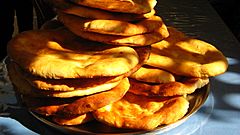
Many types of bread are baked in Azerbaijan. These include flatbread, rolling bread, lavash, sengek, xamrali, thick bread, thin bread, crepes, cakes, and tandoor bread. In the Middle Ages, tandoor ovens were common in places like the Old City (Icheri Sheher). This has been found during archaeological digs in different parts of the Old City. In Ethiopia, the UNESCO Intergovernmental Committee for the Safeguarding of the Intangible Cultural Heritage decided to add lavash to its list of important cultural heritage.
See also
 In Spanish: Gastronomía de Azerbaiyán para niños
In Spanish: Gastronomía de Azerbaiyán para niños


